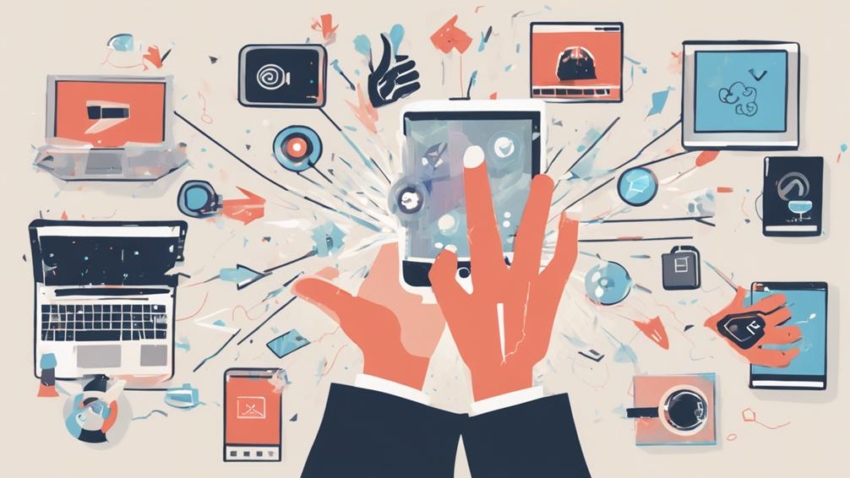
Mastering the Art of Persuasion in Digital Marketing
You've poured your heart into crafting the perfect marketing strategy, but without a deep understanding of what drives your customers' decisions, your message will fall flat. To master the art of persuasion in digital marketing, you need to dive deeper. Start by crafting compelling customer avatars, tapping into psychological triggers, and building trust with social proof. Then, leverage the power of storytelling and emotional connection through authenticity. As you continue on this journey, you'll discover the secrets to crafting irresistible calls-to-action and measuring persuasion's impact, ultimately revealing the full potential of your marketing strategy.
Crafting Compelling Customer Avatars
To create a persuasive message that resonates with your target audience, you need to develop a deep understanding of who they are, which starts with crafting a detailed and compelling customer avatar. This involves more than just creating a demographic profile; it requires digging deeper to understand their motivations, pain points, and behaviors. Effective customer profiling is key to identifying your ideal customers and tailoring your message to resonate with them.
Data segmentation is vital in this process, as it allows you to categorize your audience based on shared characteristics, behaviors, or preferences. By doing so, you can create targeted buyer personas that capture the essence of your ideal customers. These personas should be detailed and specific, outlining their goals, challenges, and preferences. This will enable you to craft a message that speaks directly to their needs, increasing the likelihood of conversion.
When crafting your customer avatar, consider the following: What are their pain points, and how can you solve them? What are their goals, and how can you help them achieve them? What are their preferences, and how can you tailor your message to resonate with them? By answering these questions, you'll be able to create a persuasive message that resonates with your target audience, increasing the effectiveness of your marketing efforts.
Understanding Human Psychology Triggers
By understanding what drives your ideal customer's behaviors and decisions, you can now tap into the psychological triggers that motivate them to take action. As a master marketer, you're not just selling products – you're influencing people's choices. It's essential to grasp the underlying psychological triggers that drive human behavior.
Priming effects, for instance, can have a substantial impact on your customer's purchasing decisions. By subtly introducing specific words or images, you can prime your audience to respond positively or negatively to your message. Loss aversion is another powerful trigger, as people tend to fear losses more than they value gains. By framing your message with a focus on what they stand to lose, you can create a sense of urgency and motivate action.
Cognitive biases, such as confirmation bias and the availability heuristic, can also be leveraged to your advantage. Emotional appeals, which tap into your customer's emotional experiences, can create deep connections and drive loyalty. Social norms, or the desire to fit in, can be utilized through social proof and user-generated content. Finally, reciprocity tactics, where you provide value upfront, can create a sense of obligation and encourage customers to take action. By understanding and applying these psychological triggers, you'll be well on your way to mastering the art of persuasion in digital marketing.
Building Trust With Social Proof
As you work to build trust with social proof, you'll want to focus on establishing credibility quickly, showcasing real results that speak for themselves, and building social credence that resonates with your audience. By doing so, you'll create a sense of authority and reliability that makes people more receptive to your message. By leveraging these strategies, you'll be well on your way to building trust that lasts.
Establish Credibility Fast
You've likely experienced the instant credibility boost that comes when a respected influencer or industry expert endorses a product or service. This phenomenon is rooted in the power of social proof, where third-party validation instills trust and confidence in potential customers. To establish credibility fast, you can leverage expert endorsements and rapid certification to accelerate trust-building.
Expert endorsements from thought leaders in your niche can instantly elevate your brand's reputation. When a trusted authority figure puts their stamp of approval on your product or service, it sends a powerful signal to potential customers. This can be achieved through collaborations, testimonials, or even just a simple social media shoutout.
Rapid certification is another way to swiftly establish credibility. Obtaining recognized certifications or badges can demonstrate your expertise and commitment to quality. This can be particularly effective in industries where certification is seen as a hallmark of excellence. By incorporating expert endorsements and rapid certification into your marketing strategy, you can quickly establish trust with your target audience and pave the way for persuasive marketing success.
Showcase Real Results
Social proof is most convincing when it's backed by concrete numbers and tangible outcomes, so start showcasing real results that demonstrate the impact of your product or service. By doing so, you'll be able to build trust with your audience and establish credibility in your industry. To effectively communicate your results, consider using data visualization techniques to make your metrics more engaging and easy to understand.
Here's an example of how you can showcase real results using a simple table:
| Success Metrics | Before | After |
|---|---|---|
| Website Conversion Rate | 2% | 5% |
| Average Order Value | $50 | $75 |
| Customer Retention Rate | 60% | 80% |
Build Social Credence
Building trust with social proof requires leveraging the opinions and experiences of real people who have used your product or service, making it an essential component of your persuasion strategy. You can achieve this by showcasing customer testimonials, reviews, and ratings on your website or social media channels. This will help potential customers feel more confident in their purchasing decisions.
Another way to build social credence is by partnering with influencers who have a large following in your target market. Influencer partnerships can increase brand awareness and credibility, especially when they share their personal experiences with your product or service. You can also leverage brand mentions on social media, where satisfied customers share their positive experiences with your brand. Displaying social badges, such as "Trusted by 10,000+ customers," can also contribute to building trust. Expert endorsements from thought leaders in your industry can further solidify your brand's credibility. Finally, engage with your community by responding to comments and messages, and showcase user-generated content to build a sense of belonging and trust among your audience.
The Power of Storytelling in Marketing
Your customers are wired to respond to stories, and savvy marketers are leveraging this innate preference to craft compelling narratives that drive brand loyalty and advocacy. Storytelling is an art that transcends traditional marketing methods, allowing you to connect with your audience on a deeper level. By sharing relatable experiences, values, and passions, you can create an emotional bond that fosters trust and loyalty.
Brand Legends, such as Apple and Nike, have mastered the art of storytelling, weaving narratives that resonate with their audience. These Cultural Icons have become synonymous with innovation, creativity, and excellence, making their brands almost mythical. You can do the same by crafting a narrative that speaks to your customers' desires, fears, and aspirations.
Storytelling is not just about sharing facts; it's about conveying emotions, values, and beliefs. It's about creating a sense of belonging, of being part of something bigger than themselves. When you share your brand's story, you're not just selling a product; you're selling a dream, a vision, or a lifestyle. By doing so, you'll create a loyal following that will advocate for your brand, driving referral marketing and ultimately, revenue growth. So, don't just sell a product – tell a story that inspires, motivates, and leaves a lasting impression.
Emotional Connection Through Authenticity
As you work to create an emotional connection with your audience, you'll find that authenticity is key. You can't fake it – people can sense when you're being insincere, and it's a major turnoff. By humanizing your brand and sharing genuine stories, you'll start to build trust and rapport with your audience, paving the way for a deeper connection.
Humanizing Your Brand
By embracing authenticity, you can transform your brand into a relatable entity that resonates with your target audience on a deeper level. This is where humanizing your brand comes in – making your brand more relatable and personable. A key aspect of humanizing your brand is showcasing your brand personality. This can be achieved by highlighting your brand's values, mission, and purpose.
| Aspect | Description | Example |
|---|---|---|
| Brand Personality | The tone, language, and attitude of your brand | Friendly, Professional, Humorous |
| Employee Voices | Featuring employee stories and experiences | Employee testimonials, Behind-the-scenes content |
| User-Generated Content | Encouraging customers to share their experiences | Customer reviews, Social media testimonials |
| Brand History | Sharing your brand's story and milestones | Founders' stories, Company anniversaries |
| Imperfections | Showing vulnerability and imperfections | Apologies for mistakes, Lessons learned |
Genuine Storytelling Matters
Crafting genuine stories that resonate with your audience requires authenticity, making it essential to share experiences that evoke emotions and spark meaningful connections. You're not just selling a product; you're sharing a piece of yourself. When you share your brand's story, you invite your audience to connect on a deeper level. This connection is what sets you apart from competitors and fosters loyalty.
Brand Legends, for instance, are built on the foundation of authentic storytelling. By sharing your brand's history, values, and mission, you create an emotional connection with your audience. Customer Chronicles, on the other hand, highlight the transformative power of your product or service. By showcasing real people and their experiences, you create social proof and build trust. Remember, authenticity is key. Don't try to manufacture a narrative; instead, share your genuine story and let your audience connect with your brand on a human level. The result? A loyal customer base that resonates with your brand's values and mission.
Using Scarcity to Drive Action
You've likely encountered situations where a product's limited availability sparked an overwhelming urge to make a purchase, and that's because scarcity can be a powerful motivator. As a marketer, you can harness this psychological phenomenon to drive action and boost conversions. One effective way to do this is by creating limited windows of opportunity. For instance, you can offer a discount or promotion that's only available for a short period, creating a sense of urgency that prompts customers to take action.
Timed offers are another way to leverage scarcity. By setting a deadline for a promotion or limited-time offer, you create a sense of FOMO (fear of missing out) that motivates customers to act quickly. This strategy is particularly effective when combined with email marketing campaigns, where you can create a sense of exclusivity by offering early access to a limited-time offer.
To maximize the impact of scarcity, make sure to communicate the limited nature of the offer clearly and prominently. Use countdown timers, limited-time badges, and scarcity-driven language to create a sense of urgency. By doing so, you'll create a sense of scarcity that drives action and motivates customers to take advantage of your offer before it's too late.
Leveraging User-Generated Content
As you explore the power of user-generated content, you'll discover how it can become a game-changer in your persuasion strategy. By leveraging social proof, you'll be able to tap into the credibility and trust that comes with customer testimonials and reviews. Now, let's examine how authenticity in advertising and empowering brand ambassadors can help you take your persuasive abilities to the next level.
Social Proof Strategies
By showcasing real customers' experiences through user-generated content, you can create a powerful social proof that instantly builds trust and credibility with potential clients. This strategy is particularly effective in digital marketing, where customers are constantly seeking validation before making a purchase. By leveraging user-generated content, you can tap into the power of social influence and create a sense of FOMO (fear of missing out) that drives conversions.
Here are some social proof strategies you can use to boost your digital marketing efforts:
- Influencer Endorsements: Partner with influencers who have a large following in your target audience to promote your products or services. This can be especially effective if the influencer has used your product and can provide a genuine review.
- Customer Referrals: Encourage your satisfied customers to refer their friends and family in exchange for rewards or incentives. This can create a viral loop that drives word-of-mouth marketing and increases brand awareness.
- User-Generated Content Campaigns: Launch a social media campaign that encourages customers to share their experiences with your brand. This can be in the form of photos, videos, or testimonials that showcase your product or service in action.
Authenticity in Advertising
When you incorporate user-generated content into your advertising strategy, you're not just showcasing your product or service – you're showcasing real people's experiences, which can be a powerful authenticity trigger that resonates with potential customers. This kind of social proof is invaluable, as it humanizes your brand and creates a sense of relatability. By leveraging user-generated content, you're demonstrating genuine transparency and a willingness to be vulnerable, which can be incredibly persuasive.
As you curate and feature user-generated content, you're fundamentally saying, 'We trust our customers to tell our story.' This brand vulnerability can be a game-changer, as it shows that you're confident in your product or service and willing to let your customers be the heroes. By doing so, you're creating a sense of community and social proof that can be incredibly persuasive. When you prioritize authenticity in your advertising, you're more likely to attract customers who resonate with your brand values and are willing to become loyal advocates. So, don't be afraid to get real and showcase the genuine experiences of your customers.
Empowering Brand Ambassadors
How do you turn satisfied customers into passionate brand ambassadors who voluntarily promote your brand, sharing their experiences with others and inspiring social proof that drives conversions? By empowering them, you create a loyal community that becomes an extension of your marketing efforts. You can't buy this kind of advocacy; it's earned through exceptional customer experiences and thoughtful engagement.
To fuel your brand ambassadors, focus on:
- Exclusive access: Offer early access to new products, services, or features to make them feel valued and part of an inner circle.
- Recognition and rewards: Publicly acknowledge and reward their contributions, whether through social media shoutouts or tangible incentives.
- Feedback and co-creation: Encourage open dialogue and involve them in product development or marketing strategy to foster a sense of ownership and accountability.
Mastering the Art of Urgency
Creating a sense of urgency in your message can catapult your persuasion efforts, as it taps into the fundamental human fear of missing out on a valuable opportunity. By crafting a sense of urgency, you'll create a compelling reason for your audience to take action now, rather than putting it off until later. This is particularly effective when combined with limited-time offers or scarce resources, which amplify the pressure to act quickly.
To master the art of urgency, you need to create a time pressure that resonates with your audience. This can be achieved by emphasizing the benefits of acting quickly, such as exclusive access to a limited-time promotion or early bird discounts. By doing so, you'll create a sense of FOMO (fear of missing out) that motivates your audience to take immediate action.
Limited availability is another powerful tool in your arsenal. By highlighting the scarcity of a product or service, you'll create a sense of exclusivity that makes your audience more likely to take action. For instance, you could create a limited-time offer, such as a "while supplies last" promotion or a "limited edition" product. By leveraging time pressure and limited availability, you'll create a potent combination that drives conversions and boosts your persuasion efforts.
Crafting Irresistible Calls-to-Action
By leveraging the sense of urgency you've created, you can now seal the deal with a call-to-action that's impossible to resist. Crafting an irresistible CTA is both an art and a science, requiring a deep understanding of CTA psychology and the triggers that drive human action.
To create a CTA that drives results, focus on the following key elements:
- Create a sense of scarcity: Use limited-time offers, exclusive deals, or limited availability to create a sense of FOMO (fear of missing out).
- Use action-oriented language: Verbs like "Get," "Discover," and "Uncover" create a sense of excitement and encourage immediate action.
- Make it visually appealing: Use contrasting colors, bold fonts, and eye-catching graphics to draw attention to your CTA and make it stand out from the surrounding content.
Measuring and Optimizing Persuasion
You've crafted a compelling message and persuasive call-to-action, but now it's time to determine whether your efforts are paying off. Measuring and optimizing persuasion is important to refine your strategy and maximize results. To do this, you'll need to delve into data analysis.
Conversion analytics will help you track the performance of your call-to-action, identifying areas that need improvement. By analyzing metrics such as click-through rates, conversion rates, and bounce rates, you'll gain valuable insights into your audience's behavior. This data will enable you to refine your message, adjust your targeting, and optimize your landing pages for better performance.
Data mining is another essential tool in your optimization arsenal. By digging deeper into your data, you'll uncover patterns, trends, and correlations that can inform your persuasion strategy. For instance, you might discover that a specific demographic responds better to certain messaging or that a particular channel drives more conversions. Armed with this information, you can tailor your approach to resonate more effectively with your target audience.
Frequently Asked Questions
How Do I Balance Persuasion With Authenticity in My Marketing Strategy?
You're wondering how to strike a balance between persuasion and authenticity in your marketing strategy. It's a delicate dance. To start, prioritize brand transparency – be honest and open about your products or services. This builds consumer trust, which is key to successful persuasion. Remember, authenticity breeds credibility, and credible brands persuade effectively. By being transparent and genuine, you'll create an environment where persuasion feels natural, not forced.
Can I Use Persuasion Techniques on My Existing Customer Base?
You're wondering if it's okay to "nudge" your existing customers with persuasion techniques. Think of it as "refining" your relationship with them. You've already won them over, now it's about deepening that connection. By using persuasion to build loyalty, you're investing in customer retention. It's not about manipulating, but about creating a sense of belonging. So, yes, you can use persuasion techniques to nurture your existing customer base, fostering loyalty and turning them into brand ambassadors.
Are There Any Ethical Concerns I Should Consider When Using Persuasion?
When leveraging persuasion techniques, you must consider the ethical implications. Be cautious of Dark Patterns, manipulative tactics that exploit psychological vulnerabilities. You have a moral obligation to prioritize transparency and respect for your audience's autonomy. Remember, persuasion should empower, not deceive. Guarantee your strategies align with your values and maintain a customer-centric approach. By doing so, you'll build trust and foster long-term relationships, rather than risking reputational damage.
How Do I Adapt Persuasion Strategies for Different Cultural Audiences?
You're about to discover the secrets of persuading a billion people worldwide! When adapting persuasion strategies for different cultural audiences, remember that one-size-fits-all messaging won't cut it. You need to explore cultural nuance, understanding that what resonates in Tokyo won't necessarily resonate in Timbuktu. Craft global messaging that's sensitive to local values, customs, and communication styles. By doing so, you'll guarantee your message lands like a perfectly placed puzzle piece, regardless of cultural context.
Can AI and Automation Enhance Persuasion in Digital Marketing Campaigns?
You're wondering if AI and automation can supercharge persuasion in digital marketing campaigns. The answer is yes! Personalization algorithms can tailor messages to individual preferences, increasing engagement. Chatbot psychology helps craft conversational flows that build trust and rapport. By leveraging these tools, you'll create highly targeted, empathetic experiences that drive conversions. The result? More persuasive campaigns that resonate with your audience and drive real results.











